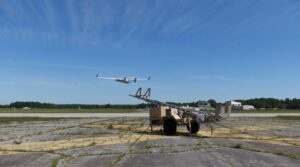
The Navy conducted the first flight test of the Guardian detect and avoidance system as it seeks to make manned/unmanned teaming safer ahead of tests with the MQ-25A Stingray unmanned tanker. The service said Guardian will work by tracking manned and unmanned systems across a 200 nautical mile radius airspace via ground-based sensors. The system then provides visual cues to unmanned air vehicle operators in ground control stations for navigation and traffic avoidance maneuvers when collisions are imminent. In the…

 By
By 











